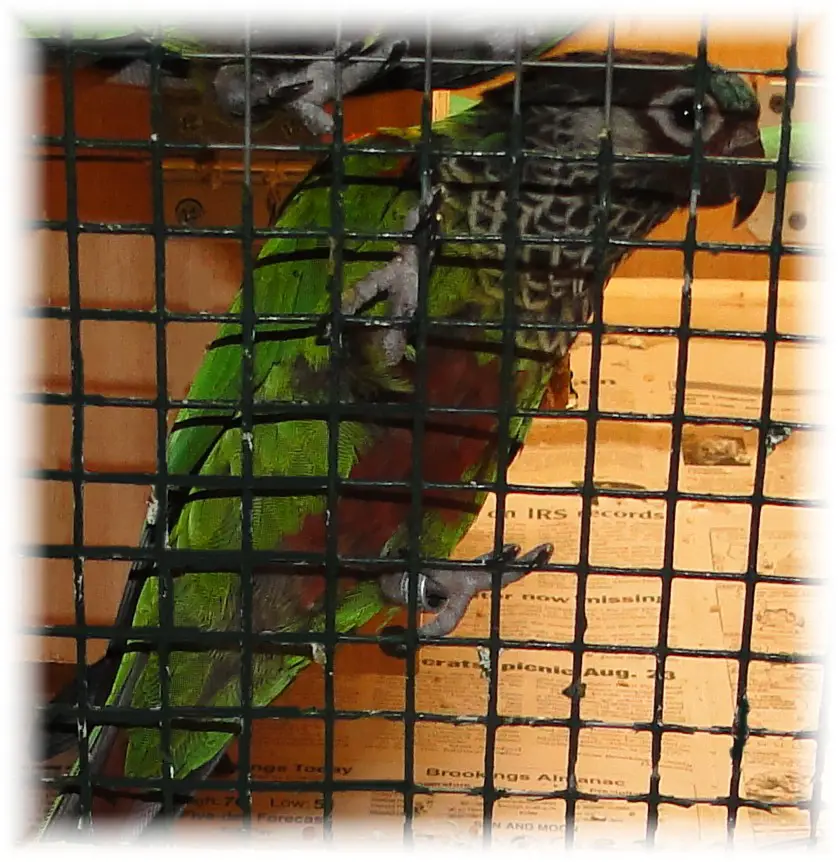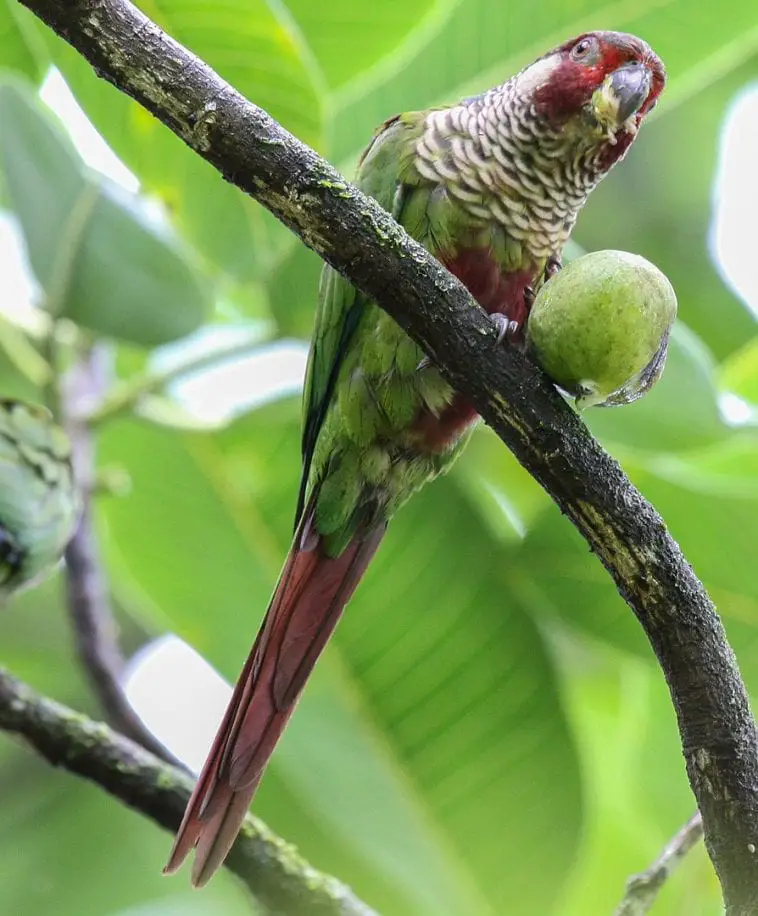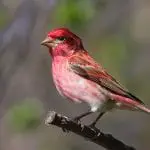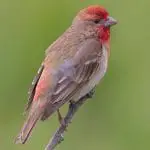Scientific Facts
| Common Name: | Painted conure |
| Scientific Name: | Pyrrhura picta |
| Life Span: | 13 to 15 years |
| Size: | 22 centimeters or 8.6 inches |
| Habitat: | Riverine formations, cloud forest, and evergreen forest |
| Country of Origin: | Venezuela, south Rio Orinoco, Guianas, North Brazil |
Physical Description

The painted conure is a small bird that measures 8.5-9.6 inches long, from head to tail. Its plumage is mostly green while the nape and crown are dark brown and suffused with a shade of blue on its forecrown. The area between its eyes and beak on the sides of the head, including the upper cheeks, are all in a reddish-brown shade. Those feathers that cover the ears are all buff white.
Also, the painted conure has a reddish-brown spot in the middle of its abdomen and another brownish-red patch that extends from its lower back to its upper tail feathers. The primary feathers on the wing and external webs of the longest feathers on these areas are blue. The top part of the tail is brownish-red while the base is green. The bill of this bird is brownish grey, the irises are brown, while the legs are grey.
The colorings are the same for all painted conures regardless of gender. The become fully mature at the age of 2. Their flight seems to be direct and swift.
Habitat
The painted conure prefers to live in tall, dense trees. It also likes to move around most of the time. This little bird becomes conspicuous through its loud calls. However, it is hard to locate in the wild because of its camouflaging plumage. The painted parakeet or painted conure is endemic to the northern part of South America, particularly in Guianas and in a big part of the Amazon Basin, excluding the northwest Basin in Colombia, Bolivia, Brazil, Ecuador, Guyana, French Guiana, Suriname, Peru, and Venezuela. This bird also exists in Central America – in Panama, to be specific.
Life Span
Like other domestic animals, the painted conures can live with you for 13 to 15 years. You can even stretch this timeframe by making sure you have provided everything that the bird needs to stay healthy and active.
Personality

This little bird tends to be noiseless compared to other conures like the green-cheeked conure. Well-tamed painted conure could be so sweet-natured. It’s hardly seen living in captivity. This bird is in demand as a pet due to its endearing disposition and beautiful coloring. You will immediately fall in love with this animal right from the first time you see it.
Also, the painted conure is active and energetic. It loves to play, so be sure you always spare some time to play with this little creature. Considering its playful and cheerful personality, this bird should have a spacious cage that can accommodate a wide array of toys. Also, the cage should have natural branches as this bird loves to climb.
Your pet needs constant attention and care. A bored or neglected animal becomes more prone to feather plucking. Though it is an active conure, it tends to be not so noisy except when it feels excited or alarmed. It enjoys bathing and chewing the fresh branches inside the cage. Therefore, you have to make sure its toys and branches are all safe to chew.
Vocalizations and Calls
During the flight, this bird makes a short “eek” sound. Its contact call is the loud “peeah”. Also, when the bird perches, it makes a “kleek-kleek” sound.
Feeding and Diet
Its natural diet should include fruits like berries, seeds, flowers, vegetable matter, and insects, including their larvae. It occasionally feeds on algae that exist on the pond’s surface. When raised in captivity, you can offer this bird with more fresh fruits, veggies, and leafy greens.
You can also give freshly cut branches with buds and leaves for extra nutrition. Do it as often as possible. This will satisfy the urge of your pet to chew. A high-quality seed mix containing safflower seeds, sunflower seeds, oats, hemp, millet, buckwheat, rowanberries, and canary grass seeds must be available in all cases.
Aside from that, you can offer your pet with sprouted seeds and millet spray. Give them to your pet several times every week. Don’t forget to give vitamin and mineral supplements to your pet when necessary.
Breeding and Reproduction
The painted conure is somewhat challenging and tricky to breed. Thus, this type of conure is not suitable for first-time breeders. As some pairs of birds can breed readily, some pairs don’t show interest in this matter.
A newly imported, painted conure can be nervous and shy. It may never confide with its keeper. However, a well-raised and trained captive painted conure can be inquisitive and friendly. It becomes susceptible throughout the acclimatization time but becomes hardy once it gets used to.
When it’s not time to breed, the painted conures form a colony system within a big flight consisting of pure painted conures and other similar species. However, it is still best to separate the pairs that are ready to breed because they could disturb one another. They may even become more aggressive to other birds within the flight at this period.
When copulation is successful, the female will prepare a nest that may carry up to 9 eggs. On average, a clutch may have 4-9 eggs. Both the male and female painted conures will incubate the eggs. The incubation period may last for 21 to 23 days. If the male is not incubating the eggs, it will normally sit on the nesting box or anywhere close to it. This way, it can protect the eggs from danger, especially when the predators are around.
The young painted conures will fledge 50 days after they come out of the eggshells. This new generation will be ready to breed in the next 2 years of their lives.
In most cases, a painted conure breeds only once in a year, but it may breed twice as well. It will breed twice a year only when the previously released clutch has been pulled earlier for hand-rearing.
The painted conure enjoys flying, so you should provide it with a wide and roomy flight that measures 9 feet tall, 3 feet wide, and 6 feet long. Don’t leave your pet exposed to lower temperatures. Keep in mind that temperatures below 5 degrees Celsius or 41 degrees Fahrenheit can be dangerous for a painted conure.
A roosting box must be available, as well. It should measure 20 centimeters long x 20 centimeters wide, and 70 centimeters tall. If not, provide your pet with a tree stump that measures 1.5 square meters or 16 square feet per pair in a communal aviary.
The dimensions may widely vary, though, as they depend on the preferences of both the bird and its owner. The likings of breeding conures may also depend on the type and dimensions of the nest box or log where the bird hatched and trained.
Whenever possible, provide your breeding pets with their preferred types and sizes of nest boxes or logs placed in different areas inside the aviary. When the breeding pair identified its favorite, don’t forget to keep it for them. Likewise, you need to remove the spare boxes.
Before you move then to a different flight, be sure that the nest box or log has been cleaned to make sure the receptacle comes with the least contamination of parasites, mites, and pathogens.
Temperament and Behavior
A hand-fed captive-bred painted conure could become a great pet, but this bird tends to be a bit more nervous, unlike the green-cheeked conure. Some pairs can be trickier to breed compared to others.
Whatever the case of your pets is, always treat the pair with respect and love and never neglect these birds. They are not as simple as beautiful flowers that will be okay with just sunlight and water. Your painted conures are sociable animals that will grow and stay healthy only with your tender love and care.
Housing

Painted conures require a cage that is at least 24 inches wide, 18 inches deep, and 24 inches tall. This cage should have a bar space that measures roughly ½ inches. Though the painted conure chews not as recklessly as other species, still they do. Hence, the cage of your pets must be the one made of powder-coated metal that is 100% safe for the birds.
Put a tough manzanita perch inside the cage. Make sure it’s of the best quality to avoid having to change it frequently. Of course, the perch should be safe to chew. The same is the case for the toys. Provide your pets with bird-safe toys and perches.
Exercise plays an important role in the lives of your painted conures, too. Therefore, you also need to provide them with a play gym that will allow them to exercise every day.
Painted Conures as Pets
In general, the conures make good pets for families for as long as they’ve been well-socialized. They don’t mind if you spend several hours playing them. The more time you play with them, the happier these birds become.
Painted conures are good pets to keep if you have kids at home. They love to get along with the entire family members. They want everyone to pay attention to them. These birds will be so happy if they find everyone is looking at them.
Just like cats and dogs, the painted conures love being touched. That’s also a reason why these birds do well with children.
Where to Get One?
Conures, especially the painted conures, are widely available on the local and online pet stores today. You may also find and get them from the local breeders in your area. To be sure of your pets’ health and vitality, it is best to get your pets only from a trusted source, whether online or offline. Do your homework before you buy.
How to Care for a Painted Conure?
Like other parrots, the painted conures are so sociable. They need daily interaction with their owners, or else they will be lonely or bored, which makes them sick. You need to constantly pay attention to these animals and play with them for a while. This will help prevent your pets from developing behavioral problems.
Also, these birds need social interaction with everyone in the family. If you are too busy that you can’t give some time for these birds, this will increase your pets’ susceptibility to sickness and behavioral changes.
Keep your pets in the family room and leave the cage open. You may also let your pets stay on the playpen when you have a guest at home. If you can’t play with your pet, at least take them out of the cage and talk to them. Petting them will be nice. You can also try putting them on your shoulders while you’re surfing the web or watching the TV.
FAQs
Does the painted conure love to play?
The painted conure is a very sociable animal that will always crave for your attention. Playing with this bird will keep the animal itself happy, tamed, and healthy.
Can a painted conure talk?
Unlike other conures like the green-cheeked conure, the painted conure is not a talking cat. Instead, it loves to make a “squeak-squeak” sound.
Is a painted conure a noisy and loud bird?
If you want to keep a conure but worried about its tendency to be noisy, go for a painted conure. This species tends to be less noisy compared to the green-cheeked conure that is more likely to be loud and disturbing for your neighbors.
What does the painted conure prefer to eat?
The painted conure enjoys a variety of foods as you can feed it with plants and small animals. You can feed it with berries, flowers, seeds, vegetables, and insects, including their larvae.
Is a painted conure a good pet for kids?
The painted conure is very friendly that they want to be the center of attention. It enjoys getting attention from everyone in the family, including the kids.



